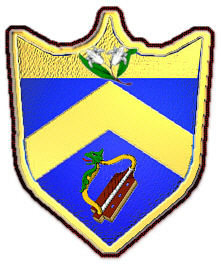Kidzworld.com tells us that medieval women were forced to
wear chastity belts. Cracked.com reports it as an act of “medieval crotch
warfare.” And don’t get me started on Mel Brooks (soon to be reviewed on this
blog). But were chastity belts medieval devices used to control women and
preserve virginity? Virginity was highly prized in the Middle Ages, but no
female was walking around with a chain and lock on her privy parts! Consider
how this popular notion of the Middle Ages shapes our ideas of the medieval past
. . . yet this idea is wholly invented.
Even though Pope Joan and chivalric King Arthur are also invented ideas,
at least they had the decency to emerge pre-1400.
Actual devices apparently were worn in the nineteenth
century, though I am no expert. Voltaire wrote The Padlock in 1724, and encyclopedias contained entries on the
chastity belt, linking them to medieval barbarism, of course. French literature
idealized stories about jealous husbands who had duplicate keys made as a baudy
romp through the ridiculous. In a show of misogyny, Johann Zedler, writing in
the 1700s tells us that even though husbands required chastity belts, their
wives could escape them by “changing their posture” (not sure how that works!).
Museums have taken some of those more modern devices and put them on display in Nuremberg, Cluny, and other locations, as if they were medieval
devices. If you go to Venice, visit the chastity belt at the Doge's palace. But this is invented history, and more respectable museums have
recently removed some of them, although “Torture Museums” hot on the tourist trail
wave them as happy flags of enticement to pay an extortionist admission (as you
can imagine, profits are much higher with so-called medieval chastity belts). The useful link below asks us to consider how museums not only record and preserve artifacts but also sometimes invent history.
But there is some truth too. The idea of a rope, or girdle of chastity did feature in medieval theological treatises. Alcuin of York (ie., Charlemagne’s best buddy) wrote: “Divest me of my past sins, protect me from presently imminent ones, fortify me against future ones. Provide me with due abstinence from food and drink, a chastity belt, purity of heart and lips, grant me patience, forbearance, good will, modesty, spiritual joy and total contempt of the world"; however, these are used as ideological symbolism, rather than actual artifacts. The earliest visual image of a chastity belt dates to 1405, and resides in Florence, Italy. Evidently Florentines were linked to the chastity belt in early modern references. Sketched into a book that Kondrad Keyser authored about medieval weapons, he includes the chastity belt as another weapon. Since it is roughly drawn and includes ironic comments, it has been viewed by historians as a kind of gag in the middle of a serious book. Other images include woodcuts from Germany during the Reformation era when commentary about women was often quite negative (this is the time of the witch-hunts, not the Middle Ages, Monty Pythons!). It's possible some were gag gifts as well; we simply don't have examples to date to the period we are studying. Definitely leave this class knowing that one’s virginity was important; that even men might ask to wear the rope of chastity in their fight against demons, desire, and women; and that the idea may have emerged in literature and art in a commentary on women’s sexuality, but there were not actual locks, keys, and iron that a medieval woman wore under her clothing. So don't spend too much time burdening yourself with medieval torture devices especially designed for women, but on the other hand why is it that only women wear engagement rings?
 |
| For more info, see this book Albrecht Classen's The Medieval Chastity Belt: A Myth Making Process |
 |
| From 1405. The first image of a chastity belt. |
 |
An early modern woodcut; note the man is holding the key.
|
| An example of a European franchise; of course, most of the objects are "medieval devices" |
|
 |
| Inside the museum: what tourists see inside museums and then post on websites as an outrageous medieval custom! |










